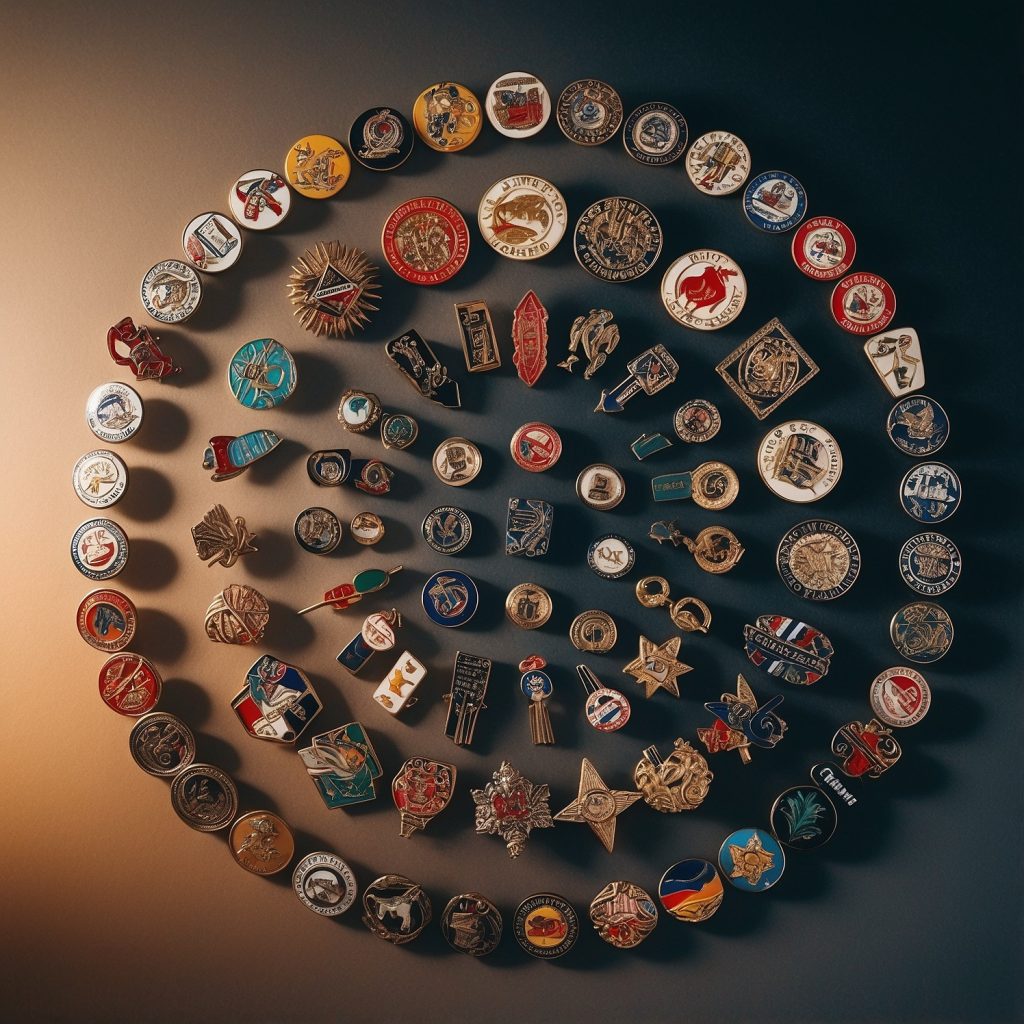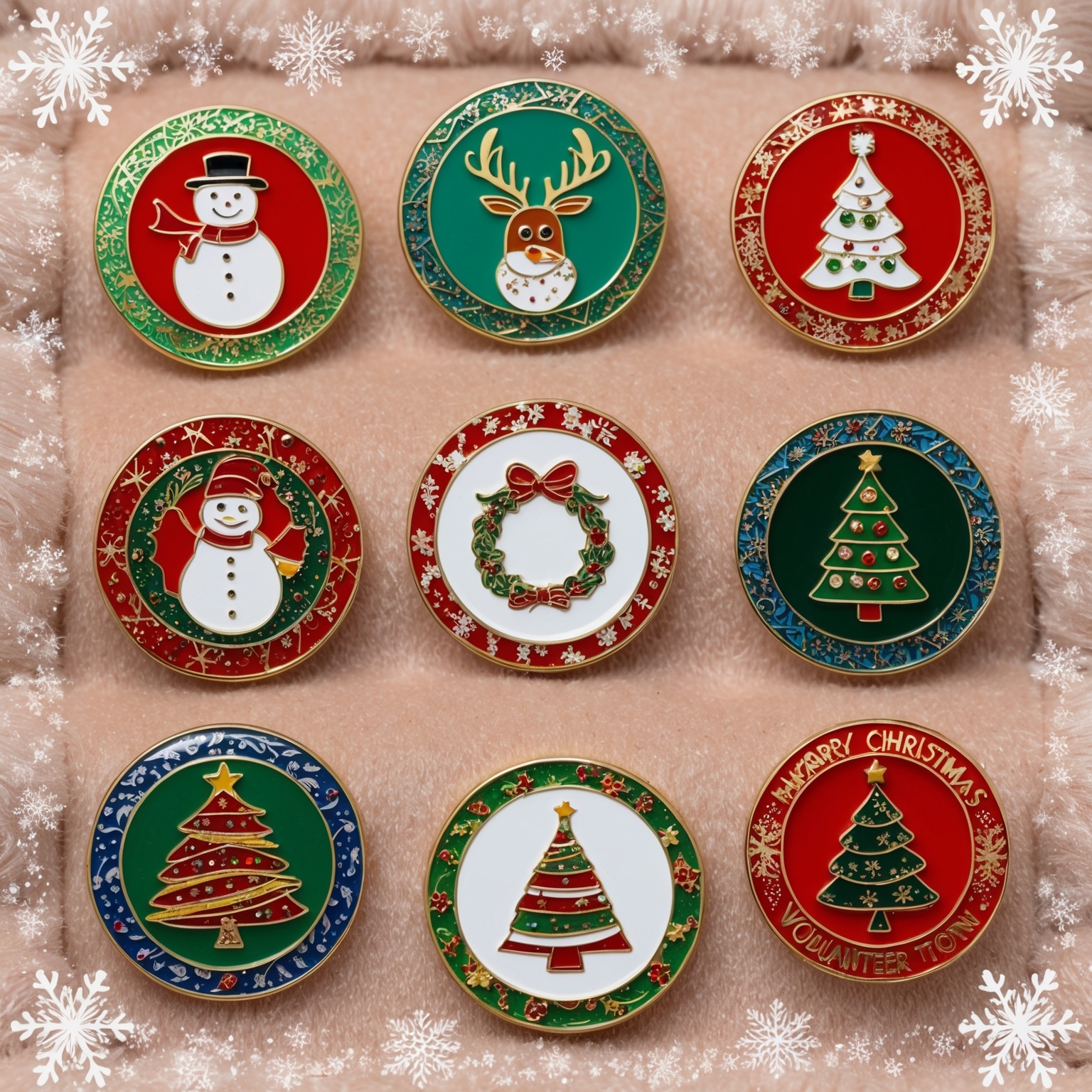Sports trading pins have long held a special place in the world of sports. These small, collectible items embody the spirit of competition, camaraderie, and tradition. Whether exchanged between young athletes at youth tournaments or traded by passionate fans during major international sporting events, sports trading pins are more than just souvenirs—they are symbols of shared experiences, team pride, and personal memories.
Over the decades, the design and culture surrounding sports trading pins have evolved significantly. What began as a simple way to represent teams and clubs has grown into a global tradition, with pins becoming increasingly intricate, customized, and valuable. Today, collectors, athletes, and fans alike treasure sports trading pins as mementos that connect them to the rich history of sports, both classic and contemporary.
In this article, we will take a journey through time to explore the evolution of sports trading pins. We’ll examine their origins, how they became integral to various sporting events, and how technological advancements and design innovations have shaped the modern pin trading culture. By understanding the evolution of sports trading pins, we can appreciate their significance in both sports history and popular culture.
The Origins of Sports Trading Pins: A Symbol of Team Pride
To understand the evolution of custom sports trading pins, we must first explore their origins. The practice of exchanging tokens or emblems in sports dates back over a century, with the first recorded instances emerging in the late 19th and early 20th centuries.
1. Early Beginnings in Baseball and the Olympics
One of the earliest sports to embrace the concept of sports trading pins was baseball, particularly in the United States. In the late 1800s, baseball teams and leagues began producing small metal pins or badges that featured team logos or player portraits. These pins were worn by fans, coaches, and players alike to show their allegiance to a team. While the primary purpose of these pins was to represent team pride, they soon became collectibles, traded among fans as tokens of their loyalty to different teams.
Around the same time, the Olympic Games—one of the world’s oldest and most prestigious sporting events—began to adopt the tradition of pin trading. The first Olympic Games to include sports trading pins was the 1896 Summer Olympics in Athens. However, it wasn’t until the 1924 Winter Olympics in Chamonix, France, that the practice of trading pins between athletes, coaches, and officials became widespread. These early pins were often simple in design, featuring the Olympic rings and the host city’s name, but they marked the beginning of a tradition that would grow exponentially in the years to come.
2. The Rise of Team Pins in Youth Sports
While sports trading pins were initially associated with professional leagues and international competitions, they quickly gained popularity in youth sports. By the mid-20th century, trading pins had become an integral part of youth baseball, particularly in Little League tournaments in the United States.
Little League baseball teams began creating custom pins to represent their clubs, towns, or regions, and these pins were exchanged between players during tournaments. The tradition of pin trading in youth sports allowed young athletes to connect with their peers from different teams, fostering a sense of sportsmanship and camaraderie. As this practice gained momentum, other youth sports leagues, including soccer, hockey, and softball, followed suit, making sports trading pins a beloved tradition across multiple sports.
The Golden Age of Sports Trading Pins: 1950s–1980s
The period between the 1950s and 1980s is often considered the “Golden Age” of sports trading pins. During these decades, the popularity of pin trading soared, and the design and production of pins became increasingly sophisticated. Several factors contributed to the rise of sports trading pins during this time, including the growth of youth sports, the expansion of professional sports leagues, and the increasing importance of the Olympics on the global stage.
1. Little League Baseball and the Expansion of Pin Trading
By the 1950s, Little League Baseball had grown into one of the largest youth sports organizations in the world. As the organization expanded, so did the tradition of pin trading. Little League World Series tournaments became a focal point for pin trading, with teams from all over the country (and eventually the world) exchanging sports trading pins as part of the competition.
The custom pins created by Little League teams during this era began to feature more detailed designs, incorporating team mascots, logos, and even representations of the players themselves. These pins were often brightly colored and made from high-quality enamel, making them both visually appealing and durable. Pin trading quickly became one of the highlights of Little League tournaments, with players eagerly swapping pins before, during, and after games.
As the tradition of pin trading grew, so did the sense of community among participants. For many young athletes, trading pins was not just about collecting souvenirs—it was a way to make new friends, celebrate shared experiences, and create lasting memories. This sense of camaraderie continues to define pin trading in youth sports today.
2. Olympic Games: A Global Stage for Pin Trading
While Little League baseball helped popularize sports trading pins at the youth level, the Olympic Games played a major role in elevating pin trading to a global phenomenon. By the 1960s and 1970s, pin trading had become a cherished tradition at both the Summer and Winter Olympics.
Athletes, coaches, officials, and fans from all over the world brought sports trading pins representing their countries, teams, or sports organizations to exchange with others. Olympic pins often featured the host city’s name and logo, along with the iconic Olympic rings. As the tradition grew, the designs became more elaborate, incorporating intricate details that reflected the culture and spirit of the host nation.
One of the key moments in the evolution of Olympic pin trading occurred at the 1980 Winter Olympics in Lake Placid, New York. It was during this event that Coca-Cola, an official sponsor of the Olympics, introduced branded sports trading pins as part of their marketing campaign. These pins featured both Coca-Cola’s logo and the Olympic rings, making them highly sought after by collectors. This move by Coca-Cola helped commercialize the tradition of pin trading and solidified its place in the Olympic experience.
From that point on, corporations, sponsors, and individual nations began producing their own sports trading pins for the Olympics, turning pin trading into a major cultural event within the games. Today, the Olympic Games remain one of the largest and most vibrant venues for pin trading, with collectors traveling from all over the world to take part in the exchange of these prized pins.
The Evolution of Pin Design: 1990s–Present
The 1990s marked a new era in the evolution of sports trading pins, driven by advancements in technology, production techniques, and design creativity. As the world became more connected through global media and the internet, the demand for unique, high-quality trading pins grew. This era saw the rise of innovative pin designs, with teams, organizations, and collectors pushing the boundaries of what could be created on a small piece of metal.
1. Technological Advancements in Pin Production
Advances in manufacturing technology during the 1990s and 2000s allowed for greater precision and detail in the production of sports trading pins. One of the most significant developments was the widespread use of die-struck and soft enamel pin manufacturing techniques, which allowed for more intricate designs and the incorporation of vibrant colors.
Die-struck pins are created by stamping the design into metal, creating raised and recessed areas that are then filled with color. This process results in a durable and highly detailed pin that can feature a wide range of textures and finishes. Soft enamel pins, which involve filling recessed areas with enamel paint, became popular due to their vibrant colors and smooth, glossy finish. These advancements allowed teams and organizations to produce sports trading pins that were not only visually striking but also highly durable.
Additionally, new materials such as glitter, glow-in-the-dark paint, and even LED lights were introduced to enhance the appearance of sports trading pins. Collectors and players alike were drawn to these creative and innovative designs, further fueling the popularity of pin trading.
2. The Rise of Customization and Team Spirit
As the production of sports custom trading pins became more advanced, customization became a key trend in the design of these pins. Teams, clubs, and organizations began creating fully customized pins that reflected their unique identities and values. No longer limited to generic logos or mascots, sports trading pins became a canvas for creativity.
For example, a Little League baseball team might design a pin featuring their team’s mascot in action, along with details like the year, location, and tournament they were participating in. Some teams went even further, incorporating movable parts, spinning elements, or even blinking lights into their pin designs to make them stand out.
The rise of customization also allowed for the creation of limited-edition and commemorative pins. For example, teams that won championships or reached significant milestones would often create special pins to celebrate their achievements. These limited-edition pins became highly sought after by collectors, adding an element of exclusivity to the pin trading culture.
3. The Role of Pin Trading at Major Sporting Events
While youth sports remained a core part of the pin trading culture, the 1990s and 2000s saw the tradition expand to other major sporting events beyond the Olympics and Little League. Events like the FIFA World Cup, the Super Bowl, and the NHL All-Star Game began to embrace the tradition of sports trading pins, creating opportunities for fans and participants to exchange pins as part of the event experience.
At the FIFA World Cup, for example, sports trading pins are created to represent the host nation, participating teams, and even individual players. Fans from all over the world come to these events with pins representing their countries or favorite teams, and the exchange of these pins fosters a sense of international camaraderie and unity.
Similarly, at the Super Bowl, fans and sponsors alike create special sports trading pins to commemorate the game. These pins often feature the logos of the competing teams, along with the event’s logo and location. Pin trading has become an exciting pre-game tradition for many Super Bowl attendees, adding to the overall spectacle of the event.
The expansion of pin trading to these major sporting events has further solidified the cultural significance of sports trading pins, making them an integral part of the fan experience at the world’s biggest sports spectacles.
The Culture of Pin Collecting and Trading: A Global Phenomenon
One of the most enduring aspects of sports trading pins is the vibrant culture of collecting and trading that has developed around them. Over the decades, pin trading has grown into a global phenomenon, with collectors from all walks of life participating in this unique hobby.
1. The Social Aspect of Pin Trading
At its core, pin trading is a social activity that brings people together. Whether it’s young athletes trading pins at a Little League tournament or fans swapping pins at an Olympic event, the act of trading creates connections between individuals. For many participants, pin trading is not just about acquiring rare or valuable pins—it’s about meeting new people, sharing stories, and building friendships.
At major events like the Olympics, FIFA World Cup, or Little League World Series, pin trading areas are often set up specifically for collectors to gather and exchange pins. These areas become lively social hubs where participants can interact with people from different countries, cultures, and backgrounds, all united by their love of pin trading. It’s not uncommon for lifelong friendships to be formed through the simple act of exchanging a pin.
2. The Growth of Online Pin Trading Communities
With the advent of the internet, pin trading expanded beyond in-person exchanges to include online communities and marketplaces. Collectors from around the world can now connect through forums, social media groups, and e-commerce platforms to buy, sell, and trade sports trading pins. Websites dedicated to pin collecting allow users to catalog their collections, share photos of rare pins, and arrange trades with fellow collectors.
Online pin trading has made it easier for collectors to find specific pins from past events, complete their collections, or acquire rare limited-edition pins. It has also helped build a global network of pin enthusiasts who share a passion for the hobby. The digital age has undoubtedly revolutionized the pin trading culture, making it more accessible and inclusive than ever before.
3. The Value of Collectible Sports Trading Pins
While sports trading pins are primarily valued for their sentimental and symbolic significance, certain pins have also become highly collectible and valuable. Limited-edition pins, pins from historic events, or pins featuring famous athletes are often sought after by collectors and can fetch significant prices on the secondary market.
For example, sports trading pins from the early Olympic Games, particularly those from the 1936 Berlin Olympics or the 1980 Lake Placid Winter Olympics, are considered valuable due to their historical significance. Similarly, limited-edition pins from major events like the FIFA World Cup or the Super Bowl can become prized items in a collector’s portfolio.
However, for most participants, the value of sports trading pins goes beyond monetary worth. These pins represent cherished memories, personal connections, and the shared experiences of sports fans and athletes around the world.
The Future of Sports Trading Pins: Blending Tradition and Innovation
As we look to the future, it’s clear that sports trading pins will continue to evolve, blending tradition with new innovations. Advances in technology, design, and manufacturing will no doubt shape the future of pin trading, but the core values of camaraderie, sportsmanship, and shared experiences will remain central to the culture.
1. Digital and Interactive Sports Trading Pins
One exciting development on the horizon is the integration of digital technology into sports trading pins. With the rise of smart devices and augmented reality (AR), it’s possible that future pins could feature interactive elements. For example, a sports trading pin might include a QR code or NFC chip that, when scanned with a smartphone, provides access to exclusive digital content, such as videos, statistics, or behind-the-scenes footage from an event.
This blending of physical and digital experiences would add a new layer of interactivity to sports trading pins, making them even more engaging for collectors and fans. Additionally, digital platforms could provide new ways for fans to showcase their pin collections online, connecting with other collectors in innovative ways.
2. Sustainability and Eco-Friendly Pin Production
As environmental concerns continue to grow, many organizations are exploring ways to produce sports trading pins using sustainable materials and eco-friendly production methods. Pins made from recycled metals, biodegradable plastics, or other environmentally friendly materials could help reduce the environmental impact of pin manufacturing.
This shift toward sustainability reflects broader trends in the sports industry, where many organizations are taking steps to reduce waste and promote environmental responsibility. Eco-friendly sports trading pins would allow collectors and participants to continue enjoying the tradition of pin trading while minimizing their impact on the planet.
From Classic to Contemporary, Sports Trading Pins Endure
From their humble beginnings as simple team badges and Olympic mementos, sports trading pins have evolved into a beloved tradition that spans generations, sports, and cultures. These small tokens have brought athletes, fans, and collectors together in the spirit of camaraderie, sportsmanship, and shared experiences. Whether traded at youth tournaments, international competitions, or major sporting events, sports trading pins tell the stories of teams, players, and moments that define the world of sports.
As we move into the future, the tradition of sports trading pins will continue to thrive, blending classic designs with contemporary innovations. Whether through advancements in design technology, the growth of online trading communities, or the development of eco-friendly production methods, sports trading pins will remain a cherished part of sports culture for years to come. In a world where sports unite people across borders and backgrounds, these pins serve as tangible symbols of the connections we make and the memories we create through the shared love of competition and teamwork.
If you are interested in buying high quality custom trading pins, you can call us at 1-800-641-1299 or fill out a FREE quote form.







